A 55-year-old male nonsmoker with metastatic lung carcinoma
A 55-year-old man from the Dominican Republic with no prior medical or surgical history presented at our institution after experiencing fever, night sweats and 12-lb weight loss over the past 2 months.
The patient — who had no history of alcohol, tobacco or recreational drug abuse — also was experiencing chest pain and dry cough.
His physical exam upon admission was negative for any findings, showed normal vital signs and was suggestive of a person in no acute distress.
Upon admission, he had a chest X-ray that showed a round opacity in the right upper/middle lobe and right paratracheal lymphadenopathy. Subsequent chest CT with IV contrast administration showed a lobulated right hilar mass contiguous with right paratracheal mass/nodal masses. The mass was abutting and narrowing the superior vena cava (SVC) and was obliterating the superior right pulmonary artery. It narrowed the inferior right pulmonary artery, the right mainstem bronchus, and proximal aspects of the right upper lobe, right middle lobe and right lower lobe bronchi.
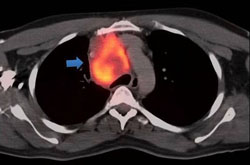
Figure 1. An axial fused PET/CT image demonstrates a hypermetabolic, right paratracheal nodal mass (arrow).
Source: Images courtesy of M. Ghesani, MD, reprinted with permission.
Given these results, our patient underwent bronchoscopy and biopsy of the right upper lobe mass (anterior segment), and they showed poorly differentiated primary lung adenocarcinoma.
His molecular tests were negative for the KRAS mutation, epidermal growth factor receptor mutation and the rearrangements of the anaplastic lymphoma kinase (ALK) gene.
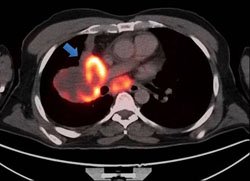
Figure 2. An axial image from the same scan demonstrates a large hypermetabolic right mediastinal/hilar mass (arrow).
As per the National Comprehensive Cancer Network guidelines, every patient with non–small cell lung cancer and positive lymph nodes must undergo a combined PET/CT scan and a brain MRI for staging purposes.
His brain MRI was negative for any disease.
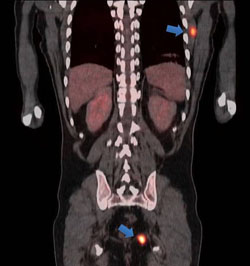
Figure 3. Coronal reformat from the PET/CT reveals hypermetabolic foci in the left serratus anterior muscle and left ischiorectal fossa (arrows).
The PET/CT showed:
- Metabolically active lymph nodes in the right neck;
-
Near-complete obstruction of the SVC;
-
Right upper lobe pulmonary artery occluded by the mass; no increase in the size of the metabolically active mass (4.9 cm x 4.4 cm);
-
Focal obliteration of the proximal right upper lobe bronchus;
-
Focal hypermetabolism in the serratus muscle;
-
Increase in size of the right adrenal nodule;
-
Clusters of metabolically active left periaortic lymph nodes;
-
A pancreatic lesion in the uncinate process;
-
A lesion in the lateral bowel wall in the right pelvis consistent with serosal metastasis; and
-
Focal hypermetabolism in the right gluteal musculature lateral to the right iliac bone.
Given the PET/CT findings, our patient underwent a CT-guided biopsy of the ischiorectal fossa, which showed metastatic lung adenocarcinoma.
Case discussion
Lung cancer is one of the most common malignancies worldwide.
In 2009, approximately 219,440 of an estimated 1,449,350 (15%) of new cancer cases, and 159,390 of 562,340 (28%) total cancer deaths in the United States were attributable to lung cancer.
The frequency of lung cancer has risen globally. It is higher in men than in women, and African Americans have the highest incidence (approximately 7.5%).
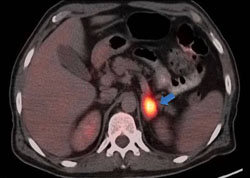
Figure 4. An axial fused PET/CT image reveals a presumptively metastatic, hypermetabolic left adrenal nodule (arrow).
About 80% of cases of lung cancer are attributed in cigarette smoking. A person who smokes one pack per day for 40 years is 20 times more likely to develop lung cancer than a never-smoker. The majority of smokers, however, will not develop lung cancer.
Although tobacco is the primary etiology for lung cancer, emerging information supports the notion that lung cancer in nonsmokers — defined as those who smoke fewer than 100 cigarettes in lifetime — is distinct enough from an epidemiologic and biologic standpoint.
Lung cancer in nonsmokers comprises about 20% of cases in men and more than 50% of cases in women. The age-adjusted incidence in nonsmokers aged 40 to 79 years is about 12 in males and around 17.5 in females per 100,000 person-years. That is similar to the incidence of myeloma in men and cervical cancer in women.
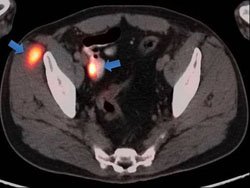
Figure 5. An axial fused PET/CT image reveals a hypermetabolic nodule in the right gluteal musculature (arrow), as well as hypermetabolic wall thickening of a segment of the small bowel (arrow), both presumptively metastatic.
Less clear is whether the incidence of lung cancer is changing. Although it has been generally accepted that lung cancer in nonsmokers happens in younger age, this has only been confirmed in studies from Asia. More pronounced are the biologic differences among smokers and nonsmokers, with mutations in EGFR and ALK being more common in nonsmokers.
Risk factors for lung cancer in nonsmokers include secondhand tobacco smoke; radon exposure, as in uranium miners; environmental exposures such as asbestos, chromium and arsenic; prior lung diseases; or exposure to prior radiation therapy or chemotherapy.
Approximately 95% of all lung cancers are classified as either small cell lung cancer (SCLC) or NSCLC. This distinction is essential for staging, treatment and prognosis. Other cell types comprise about 5% of primary lung malignancies.
NSCLC is the most common category, and it includes the following histological subtypes: adenocarcinoma, squamous cell carcinoma and large-cell carcinoma. Adenocarcinoma is the most common in both smokers and nonsmokers.
The signs and symptoms of lung cancer depend on the location and extent of the tumor. Common presentations include cough, wheezing, hemoptysis, pain or dyspnea. Many patients present with weight loss and fatigue, as in the case described above. More dramatic presentations include pneumonia, abscess or SVC syndrome.
Disease staging
The current staging system used for NSCLC takes into consideration the tumor size, location and extent of local extension and satellite nodules, lymph node involvement, and the presence or absence of distant metastasis. The new system provides better prognostic information regarding survival. In this case, the patient was diagnosed with stage IV disease because of the presence of distant metastasis.
In general, conventional CT scans have a sensitivity of 60% and specificity of approximately 80% for the detection of lung cancer. The diagnostic accuracy of CT scans can be further improved by utilization of super high-resolution scanning techniques, which have a sensitivity of about 85% and a specificity of nearly 100% for the detection of malignant endoluminal or obstructive lesions involving the airway.
Although important for the preliminary assessment of patients with suspected lung cancers, CT scans are unreliable for detection of mediastinal lymph node metastases. Therefore, any patient with a newly diagnosed lesion suspicious for lung cancer should undergo whole-body [18F]fluorodeoxyglucose (FDG)-PET imaging.
A variety of studies have compared FDG-PET with standard CT scans for staging of mediastinal lymph nodes in patients with lung cancer.
PET and CT scans both have about 70% accuracy for detection of histologically confirmed mediastinal lymph node (N2 and N3) metastases, while PET scans offer greater sensitivity (70% vs. 50%) and specificity (80% vs. 70%). Furthermore, FDG-PET scans are considerably superior to CT scans for the detection of N1 disease (42% vs. 13%; P=.017) in patients with potentially operable lung cancers. Whereas the positive predictive value of PET scans for detection of N1 or N2 nodal metastases is only 65%, the negative predictive value of PET imaging exceeds 90%.
The standard therapy today for patients with stage IV lung cancer and good performance status is palliative platinum-based couplet chemotherapy, which has been shown to improve quality of life and OS. There is a great debate regarding the number of cycles before repeating the imaging, with CT scan, to assess tumor response to therapy.
References:
Bury T. Eur Respir J. 1997;10:2529-2534.
De Wever W. Eur Respir J. 2007;29:995-1002.
Fischer B. N Engl J Med. 2009;364:32.
Gámez C. J Thorac Oncol. 2006;1:74-77.
Goldstraw P. J Thorac Oncol. 2007;2:706-714.
Groome PA. J Thorac Oncol. 2007;2:694-705.
Kim SK. J Nucl Med. 2007;48:214-220.
Lardinois D. J Clin Oncol. 2005;23:6846-6853.
Pozo-Rodríguez F. J Clin Oncol. 2005;23:8348-8356.
Weder W. Ann Thorac Surg. 1998;66:886-892.
Yi CA. J Nucl Med. 2006;47:443-450.
For more information:
Munir Ghesani, MD, is an attending radiologist at St. Luke’s-Roosevelt Hospital Center and Beth Israel Medical Center, an associate clinical professor of radiology at Columbia University College of Physicians and Surgeons, and a HemOnc Today section editor. He may be reached at Department of Radiology, Beth Israel Medical Center, First Avenue at 16th Street, New York, NY 10003; email: mghesani@chpnet.org.
Sam Altman, MD, is a resident in radiology at St. Luke’s-Roosevelt Hospital Center.
Grigorios Chrysofakis, MD, is a fellow in hematology/oncology at St. Luke’s-Roosevelt Hospital Center.
Disclosure: Ghesani, Altman and Chrysofakis report no relevant financial disclosures.
